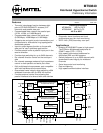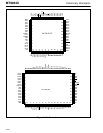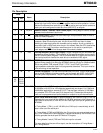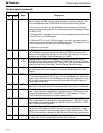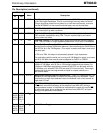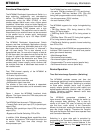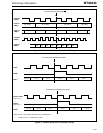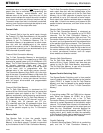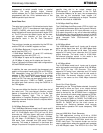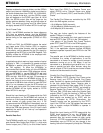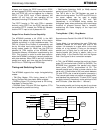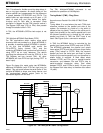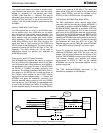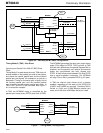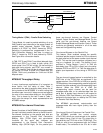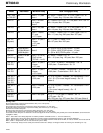
MT90840 Preliminary Information
2-238
an address-value in the path’s Data Memory. A given
output time slot is controlled by programming the
Connection Memory control-address with the
address-value of the source input time slot. At the
same control-address the output time slot is enabled
or tri-stated and other per-channel functions set up.
Thus each output time slot is individually controlled,
and any given input time slot might be copied to one,
several, or none of the output time slots.
Transmit Path
The Transmit Path is from the serial inputs, through
the Transmit (Tx) Path Data Memory, to the parallel
outputs (PDo0-7). This path is controlled by the
contents of the Tx Connection Memory. The Tx
Connection Memory is programmed, for each output
time slot, with the address-value of the source
channel to be read out of the Tx Data Memory. Up to
512 channels of serial input can be switched to up to
2430 channels of parallel output.
Transmit Path Connection Memory
The Tx Path Connection Memory is structured as
2430 words of 16 bits. This supports up to 2430 DS0
channels for parallel rates up to 19.44 Mbyte/s (155
Mbps). The Tx Path Connection Memory is accessed
as two-sub memories: High and Low. The
Connection Memory Low (2430 X 8) is the low byte
of the word, and is programmed with the
address-value of the serial-input source channel.
The Connection Memory High (2430 x 8) is the high
byte of the word. Connection Memory High holds the
high-order bit(s) of the source address-value, and is
also programmed to control per-channel functions
such as output driver-enable and programmable
control outputs.
Transmit Path Data Memory
The Tx Path Data Memory is structured as 512
words of 8 bits. Serial input time slots are converted
to parallel bytes and copied to the Tx Path Data
Memory sequentially, serial-stream by serial-stream.
The lowest address of the Tx Path Data Memory is
STi0-channel0, the next is STi0-channel1, and so on.
At 2 Mbps, with 32 channels per STi pin,
STi1-channel0 would be 32 addresses higher than
STi0-channel0. The Tx Path Data Memory is read
out to the parallel outputs by the Tx Connection
Memory.
Receive Path
The Receive Path is from the parallel inputs
(PDi0-7), through the Receive (Rx) Path Data
Memory, to the serial outputs. This path is controlled
by the contents of the Rx Path Connection Memory.
The Rx Path Connection Memory is programmed, for
each output time slot, with the address-value of the
source channel to be read out of the Rx Path Data
Memory. Up to 2430 channels of parallel input can
be switched to up to 512 channels of serial output.
Each output byte, whether switched data or message
mode data, is read from memory and passed to the
parallel-to-serial converters, and then driven out the
serial port.
Receive Path Connection Memory
The Rx Path Connection Memory is structured as
512 words of 16 bits. This supports up to 512 DS0
channels. The Rx Path Connection Memory is
accessed as two sub-memories: High and Low. The
Connection Memory Low (512 x 8) is the low byte of
the word, and is programmed with the address-value
of the parallel-input source channel. The Connection
Memory High (512 x 8) is the high byte of the word.
Connection Memory High holds the high-order bits of
the source address-value, and is also programmed
to control per-channel functions such as output
driver-enable and direction-control.
Receive Path Data Memory
The Rx Path Data Memory is structured as 2430
words of 8 bits (1 byte). Parallel input time slots are
copied to the Rx Path Data Memory sequentially.
The Rx Path Data Memory is read out to the serial
port by the Rx Path Connection Memory.
Bypass/Parallel-Switching Path
The Bypass/Parallel Switching path is from parallel
input to parallel output. Data received at the parallel
inputs (PDi0-7) is copied to the Rx Path Receive
Memory, and may be passed to the parallel outputs
(PDo0-7) under control of the Tx Path Connection
Memory.
Bypass
In ring timing modes (TM1 and TM2) this is a bypass
path. When the Bypass bit (PPBY) for a given
parallel output channel is set in the Tx Path
Connection Memory, the same-address parallel input
channel is copied (bypassed) to that parallel output
channel. This allows data channels not destined for
the local node to be bypassed to the output port and
down the ring. “Broadcast” channels destined for
every node can also be bypassed, since PPBY is an
output control, and it does not affect the availability
of the Receive Parallel data for switching to the serial
port or monitoring through the CPU interface.
Parallel Switching
In Parallel Switching Mode (TM4) this is a switching
path, and the Tx Path Connection Memory is



